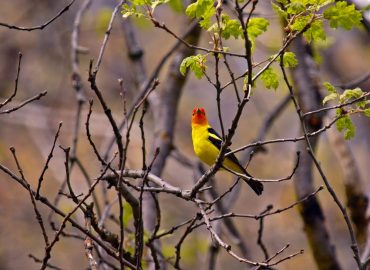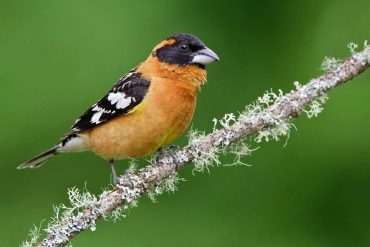
After a long, gray winter, spring’s color is a welcome tonic. Not only are the plants and trees bursting with color, the birds are doing the same.
Migrants that will nest in the Pacific Northwest bring “south of the border” color into the West Sound region. They began their migration journey from as far away as Central America and Mexico.
Western tanagers and black-headed grosbeaks flood into our yards from late April and throughout May. Many move into the mountains to nest but some stay in forested areas closer to the Sound.
Even before they are seen, they are often heard. The Western tanager has a song that bears some resemblance to that of the robin’s. However, the black-headed grosbeak’s singing has also been compared to the robin. There is even some disagreement as to who is the best singer. When a black-headed grosbeak is singing from the treetops, it is impossible to ignore. The late Roger Tory Peterson, “Dean of Birdwatchers,” described it as “sounding like a robin that has taken voice lessons.”
Western tanagers are less mellow when they break into song. The robin-like phrases are short, less sustained and more hoarse than fluid. This bird’s call note can go unnoticed but when heard, it is distinctive and identification is easy. A dry “pit-i-tic” or “pi-tic” suggests it would be worthwhile to try and see who is calling.
Both the tanager and the grosbeak are beautiful birds. Despite their brilliant coloring, they still blend in with their surroundings, making it challenging to spot them.
Western tanager males have a red head, a yellow body and black-and-white wings. The females may not be as gaudy but their overall yellowish-green plumage is also beautiful.

Male black-headed grosbeaks belong to a family of birds known for their large bills. The bill of grosbeaks of any species means they can go through sunflower seeds with rapid-fire precision. Their beaks may not be very attractive but their coloring more than makes up for this.
The male has a black head, black-and-white wings and black tail, and the rest of his body is orange-brown. The female, with her boldly striped head, looks like a giant sparrow — and so do the young birds.
Because black-headed grosbeaks are easily attracted to feeders containing sunflower seeds, they can be coaxed to nest in neighborhoods that offer this food as well as the mature trees they prefer to nest in. It may seem as though they have moved on but there is a call note the adults and the juveniles use for communicating with each other. Their soft “whee-oo, whee-oo” tells you there is a family of black-headed grosbeaks in the area.
When it comes to attracting Western tanagers, we may only get to enjoy them as they pass through our yards. It is easy to miss these traveling flocks but one thing almost always attracts them: They are looking for sources of water. Birdbaths, especially those with dripping water, draw them like magnets.
Yards with water features such as manmade waterfalls and small streams are just what they are looking for. So are many other bird species that never come to feeders. Water to drink and water to bathe in is a challenge that migrating birds face throughout their journey.
If black-headed grosbeaks decide to nest in your neighborhood, a source of water and feeders full of sunflower seeds should create endless opportunities for interesting photos.
Some of us don’t have yards the tanagers and grosbeaks will spend the summer in, but that doesn’t mean we can’t enjoy their singing and handsome plumage. You can see these birds in parks throughout the West Sound area and other parts of the Northwest.
Their numbers are even larger on the eastern side of the state so include some birdwatching in your summer camping plans. The large rivers on both sides of the Olympics and the Cascades are good habitat for both birds. They are attracted to the large, deciduous trees like the alders, willows and cottonwoods because the insects found in these trees make up a major portion of their diet.
The tanagers nest as far north as Southeast Alaska and in mature Douglas fir, pine, spruce and aspen in mountains up to 10,000 feet in elevation. Whether you are hiking in the mountains, camping near the foothills or enjoying rivers and parks on the eastern side of the state, expect to find these beautiful birds.
Lewis and Clark are credited with discovering them in what was then the large Louisiana Territory. Spring is the perfect time to discover them for your own pleasure — if you haven’t already seen these neotropicals from “south of the border.”

























